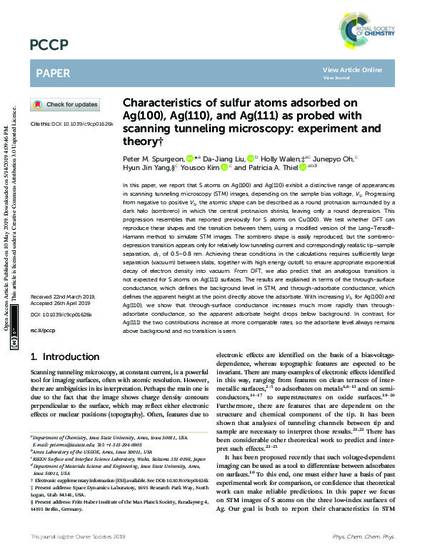
In this paper, we report that S atoms on Ag(100) and Ag(110) exhibit a distinctive range of appearances in scanning tunneling microscopy (STM) images, depending on the sample bias voltage, VS. Progressing from negative to positive VS, the atomic shape can be described as a round protrusion surrounded by a dark halo (sombrero) in which the central protrusion shrinks, leaving only a round depression. This progression resembles that reported previously for S atoms on Cu(100). We test whether DFT can reproduce these shapes and the transition between them, using a modified version of the Lang–Tersoff–Hamann method to simulate STM images. The sombrero shape is easily reproduced, but the sombrero-depression transition appears only for relatively low tunneling current and correspondingly realistic tip–sample separation, dT, of 0.5–0.8 nm. Achieving these conditions in the calculations requires sufficiently large separation (vacuum) between slabs, together with high energy cutoff, to ensure appropriate exponential decay of electron density into vacuum. From DFT, we also predict that an analogous transition is not expected for S atoms on Ag(111) surfaces. The results are explained in terms of the through-surface conductance, which defines the background level in STM, and through-adsorbate conductance, which defines the apparent height at the point directly above the adsorbate. With increasing VS, for Ag(100) and Ag(110), we show that through-surface conductance increases much more rapidly than through-adsorbate conductance, so the apparent adsorbate height drops below background. In contrast, for Ag(111) the two contributions increase at more comparable rates, so the adsorbate level always remains above background and no transition is seen.
Available at: http://works.bepress.com/patricia_thiel/155/

This article is published as Spurgeon, Peter M., Da-Jiang Liu, Holly Walen, Junepyo Oh, Hyun Jin Yang, Yousoo Kim, and Patricia A. Thiel. "Characteristics of sulfur atoms adsorbed on Ag (100), Ag (110), and Ag (111) as probed with scanning tunneling microscopy: experiment and theory." Physical Chemistry Chemical Physics 21, no. 20 (2019): 10540-10551. DOI: 10.1039/C9CP01626K. Posted with permission.